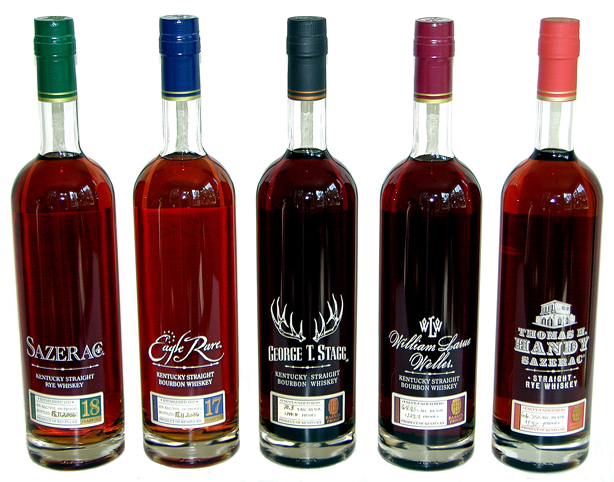Five Best Barrel Proof Bourbons
Five Best Barrel Proof Bourbons
Barrel proof Bourbon is bourbon that was bottled without the addition of water. Barrel proof bottles will usually say uncut.
It is one of the most pure forms of Bourbon you can have.
Here is a list of what I believe are the five best barrel proof Bourbons:
5. Thomas H. Handy Sazerac Rye
Ok, this is a Rye not a Bourbon but it is still excellent. Thomas H. Handy Sazerac Rye is an uncut and unfiltered straight rye whiskey. The 2012 edition was named “World Whisky of the Year” in Jim Murray’s 2013 Whisky Bible
The New Bourbonr Dictionary
Confused by the Bourbon lingo (single barrel, proof, NDP, etc.) ?
Here are some of the more common Bourbon questions answered. Feel free to add any other FAQ’s
What does Single Barrel mean?
– The Bourbon has been aged in a single barrel and only Bourbon (and water) from that barrel has been put in to the bottle.
What is Small Batch Bourbon?
-Small Batch Bourbon is when the distillery or bottler selects a small amount of barrels and mixes them together. This allows the distiller to balance flavors by adding different years and recipes to the batch as well as produce a more consistent product. The number of barrels to be considered small batch isn’t regulated but it is usually somewhere between 10-50.
2013 Fall Bourbon Releases
Fall is like Christmas for most Bourbonr’s
During the fall it feels like distilleries are releasing new bourbons every week.
Here is a partial list of the Bourbons and Whiskies set to release this fall:
Four Roses Small Batch Limited Edition (Est. Release Mid/Late September)
(the release I am most excited about) – This year, to commemorate their 125 years of distilling, Four Roses is releasing their Limited Edition Small Batch. “The recipes, each with different flavor characteristics, include an 18-year-old selection of Four Roses’ recipe coded OBSV (featuring delicate fruit, spicy and creamy characteristics), a 13-year-old OBSK (rich in spiciness, full body), and a 13-year-old OESK (spicy, full body).” If you’re not familiar with Four Roses they have ten unique recipes (2 mash bills, 5 yeast strans) which they use to craft their bourbons.
When Will Pappy Van Winkle be Available
Update 10/7/13: Old Rip Van Winkle has not set a release date for Pappy.
Breaking: 10/12/13 Pappy is spotted in Louisville at Party Source. Apparently, people were camping out in line the night before. Pappy is the new iPhone!!! Except the iPhone never brought me this much joy
Old Rip Van Winkle did announce that they were not going to have a Spring 2013 release. That should mean more bottles for the Fall!
Pappy Guess:
Mid-October
Pappy Van Winkle Release Tracker
Did you ever wonder when Pappy became so popular? Check out our recent blog post
Looking for a way to keep track of all the whiskies you’ve tasted? Go over to Bourbonr.com. A fast and simple way to keep track of your likes and dislikes
What’s The Difference Between Bourbon and Whiskey
A common questions among new Bourbonrs is “What’s the difference between Bourbon and American Whiskey”?
The answer is pretty simple but yet confusing at the same time.
First, we are going to explain what Bourbon is. Then, we will look at how American Whiskey is different.
Based on the Federal Standards of Identity for Distilled Spirits (27 C.F.R. 5) there are six standards a whiskey must meet to call itself Bourbon:
US Distilleries on the Map
Now, here is a map of all of the distilleries in the US. If there are any close to where you live you should try to take a visit.
Explore more infographics like this one on the web’s largest information design community – Visually.
Whiskey Review – Balcones Baby Blue Corn Whisky
Balcones Baby Blue Corn Whisky by Ralfy
Here is some more information about Balcones Baby Blue from the Balcones website:
Baby Blue is a unique corn whisky made from atole, a roasted blue corn meal. Baby Blue isn’t bourbon nor white lightning. It has the freshness and verve of traditional corn whisky but with a refined complexity. The result is a round nuttiness and roasty overtones with a smooth finish. Baby Blue was the first Texas whisky on the market since prohibition, and is the only craft-made whisky to have received a 5-star rating from F. Paul Pacult’s Spirit Journal other than Balcones “1” Texas Single Malt.
Buffalo Trace Antique Collection Release Date 2013
Buffalo Trace Antique Collection Release Map
Breaking News: The Buffalo Trace Antique Collections has been spotted in KY, NC, GA and Washington DC
I also saw Thomas Handy in FL but not the rest of the release
Eagle Rare 17 Year Old
The previous edition of this bourbon was honored with a Gold Medal at the 2012 International Wine and Spirits Competition. The 2013 edition was distilled in the Spring of 1993 and has been aging on the 2nd, 3rd and 6th floors of Warehouses I and K. The barrels selected for this batch were actually aged for 19 years, and the taste has been described as dry, with hints of oak, leather, and tobacco.
Pappy Van Winkle Release 2013
Updated as of 10/7/13
As of the beginning of October Old Rip Van Winkle has not set a release date for Pappy.
Old Rip Van Winkle did announce that it would not have a spring release. Instead, there would only be one release in the Fall.
Pappy Guess:
Early November
Pappy Van Winkle Release Tracker
While you’re waiting get our newiOS app and start building your Bourbon Library






